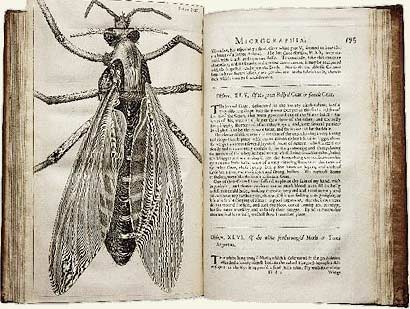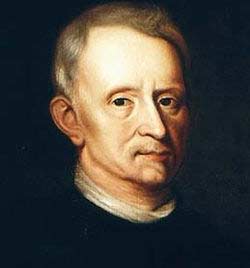Robert Hooke (1635-1703): The person who discovered the cell
In 1665, in England, a book was published entitled " Micrographia " which caused a stir in the scientific circles in England and Europe. The book contains basic discoveries in biology, including 60 large figures drawn by the author himself, including a picture of a magnifying louse several tens of centimeters in length, a huge lice occupying a whole page of the book. , the fly's complex eye, the meticulous structure of the feathers, the transformation of the fly, all with details. The author of the book is Robert Hooke, an English botanist, then 30 years old.

Flea picture in the book 'Micro-image'
Hooke's birth in 1665 (Photo: sfr.ee.teiath)
Robert Hooke was born on July 18, 1935 in an island town of Wright, near the south coast of England, in the family of a Protestant pastor. During his childhood, he was often ill but very intelligent and studious; in just two weeks he had finished the Euclidean math books. Throughout the day he was busy creating mechanical tools, ships, millmills running by flowing water, pendulum clocks, wooden planes . The year he was thirteen, his father died, he had to come and ask work in a studio, learn to paint portraits to make a living. But the smell of oil paint and paint made him headache, sick, so he had to quit his job. Hooke then came to assist the laboratory of the British Royal Society (newly established), to clean up the experimental instruments. His desire to understand motivated him to learn and attend classes himself

Robert Hooke (Photo: wikipedia)
at Oxford school.
At 26, Hooke published the first book , studying surface tension. In the mid-17th century, in Europe, many scientists tended to create and use optical devices to study nature, Hooke was also one of those contributing to that trend. . After 4 years of work, he published the research results in the famous book "Micro-image" . In the book, he fully notes the methods of conducting research: '. I chose a small room, only one window facing south. About a meter from the window, I set up a table with a microscope to study . I had to use a glass or a double-sided lens (flat and convex), convex face facing the door The window to attract a lot of light creates the source of light, then I place between the light source and the observer a piece of oil paper, a magnifying glass with a tremendous magnification to focus a lot of light through oil paper and projection On objects, but also pay attention to estimate so that the oil paper from overheating can ignite . '.
Hooke's notes demonstrate his meticulousness in research work: 'To be able to work both on non-sunlight days, and late at night, I make a vertical tool with On a horizontal rack, on a shelf with an oil lamp that can move near and far, on the other rack place a glass sphere containing transparent fluid, on the third rack a two-sided lens (convex and convex) is placed. can move in many directions' . With self-made devices like that Hooke conducts botanical studies. In the book, he noted the results obtained: 'Through the microscope I observed the cork (liège), I realized that there was a structure that resembled chambers, small holes. I used a knife to cut into many other thinner pieces and obviously I noticed that the pieces were structured like honeycomb, small rooms. I carefully counted and found that there were 60 cells (from latin cellulate, meaning: small room, so Hooke was the first to set and use the word 'cell'), the cells were close to each other. on a 1mm area, there will be over 1 million (1,666,400 true) cells on a 6.5 cm 2 area , an incredible number '. Later, Hooke decided to study more through a tiny structural microscope that he had just discovered.
At the time of his book " Micrograph", in 1665, Hooke presented to the Royal Society the results observed in the report 'Structure of cork through magnification lens'. The following year, he was elected a Fellow of the Royal Society and Secretary for 15 years. At 36, he experimented on himself on the effects of low pressure environments: he sat in a small chamber and suffered a very low pressure (only 1/4 of normal pressure) and acknowledging the symptoms he himself sensed
 Fleas in the book "Micro-image" of Hooke was born in 1665 (Photo: roberthooke.org) are like: headache, earache to near deafness etc . He also did many experiments on grafting skin, artificial respiration, blood transfusion .
Fleas in the book "Micro-image" of Hooke was born in 1665 (Photo: roberthooke.org) are like: headache, earache to near deafness etc . He also did many experiments on grafting skin, artificial respiration, blood transfusion .
Hooke was a science enthusiast , from the early morning in the lab he saw his figure: small, low and thin, his figure slightly stooped, his facial expression was not very good because his mouth was slightly wide and his chin was too pointed. He was simple and generous: during his years at the Royal Society and the university, he did not complain about wages. His character is straightforward and straightforward, easy to get impatient, colliding with colleagues (it was later known that it was due to illness from a young age that made him eat poorly and lose sleep frequently). His argument with Iss Newton Newton (1642-1727) became famous: perhaps Hooke had informed Newton of the results of his physics studies and facilitated Newton's discovery of certain The new law, but it is also possible to discover these laws by myself, so Newton did not specify Hooke's role to contribute. Anyway, this collision became contradictory to the point that only after Hooke passed the Newton examination was elected President of the Royal Society (during 1703-1727).
Hooke is not only a botanist famous for discovering cells, he is also a prominent astronomer . He has many great scientific contributions such as making telescopes, observing the rotation of celestial bodies, suggesting that the freezing temperature of water is 0 o , giving the mechanical theory of heat and research. Save the origin of fossil objects. He was also a talented architect: after the big epidemic (in 1665) and the great fire (in 1666) in London, he himself designed to rebuild many large houses and large areas. of the British capital.
The reputation Robert Hooke resounded not only during his lifetime, but also circulated centuries later, especially since no one could store a picture of him and no one knew where his grave was.
Seven years after Robert Hooke discovered the cell, in 1672, Malpighi also described small pockets in plant structure. 140 years later, in 1805, a German physician and natural scientist, Lorenz Oken (1779-1851) also affirmed: 'Every organism is made up of cells'. But 174 years after Hooke's discovery, the new cell is finally confirmed as the basic structural unit of both animals and plants, thanks to the work of Schleiden and Schwann.
Source: Book of 20 talented biologists by Tran Phuong Hanh, Youth Publishing House
- The birth of the microscope
- Identified the stem cell source of the person with muscle recovery potential
- Discover new types of cell division
- Salary of world famous scientists
- The giant manual guides people to do what if the end of the world happens
- Tesla vs Edison and the confrontations shaped the history of science
- Look at the sleeping figure guessing the humanity
- It was possible to transplant stem cells from one person to another
- Explore the magical world under a microscope
- The secret behind the cursed doll in the American Museum
- Golden bridge - 'defending champion' antibiotic resistance
- LEARN ABOUT ORIGINAL CELL (Part 3)
 The most famous scientific failures in history
The most famous scientific failures in history Mysterious genius mechanic and the machine froze time
Mysterious genius mechanic and the machine froze time The son carries the 'bad gene' of genius Albert Einstein
The son carries the 'bad gene' of genius Albert Einstein Isaac Newton
Isaac Newton